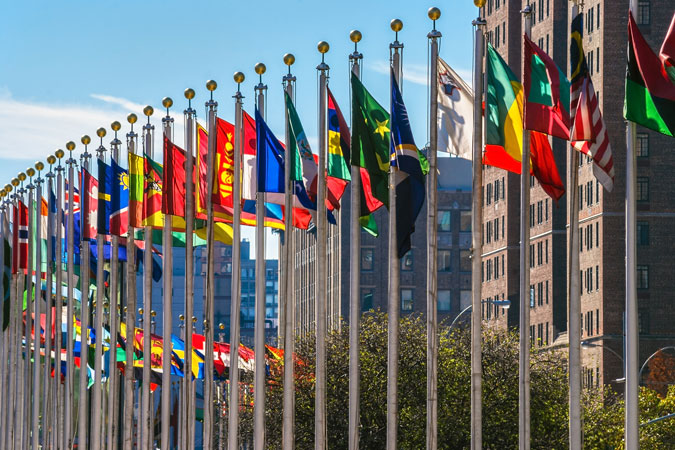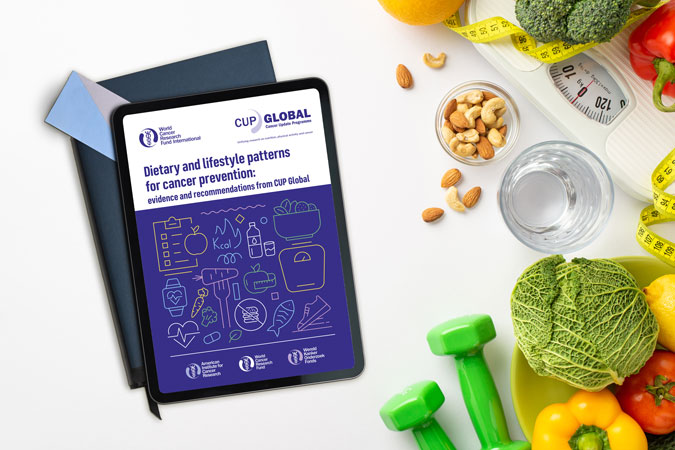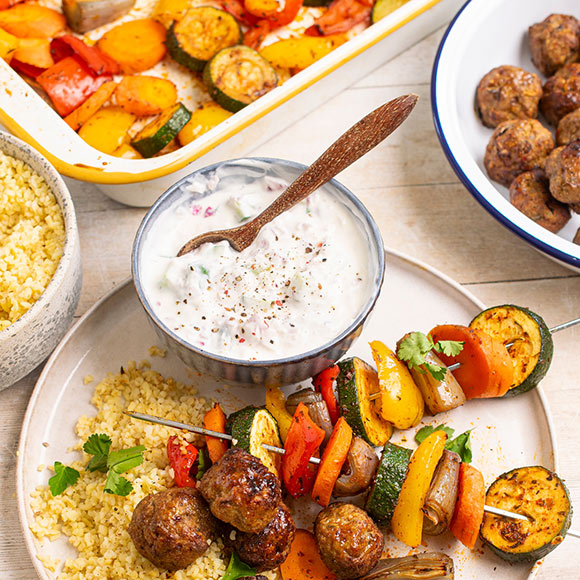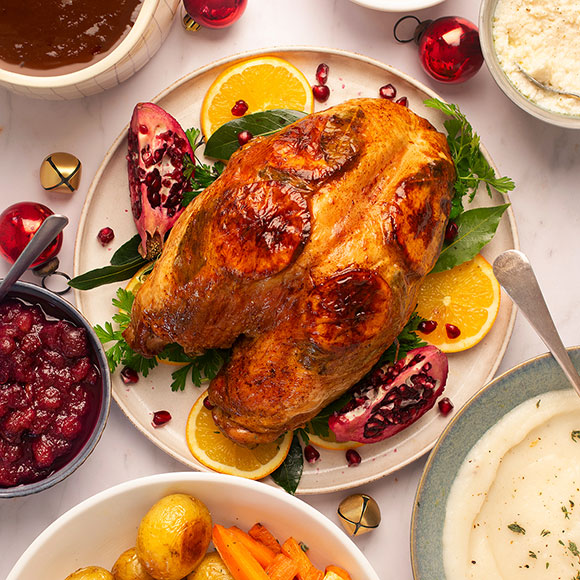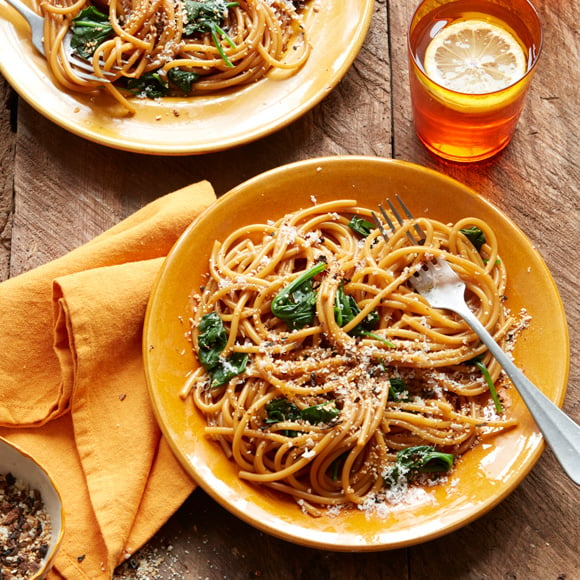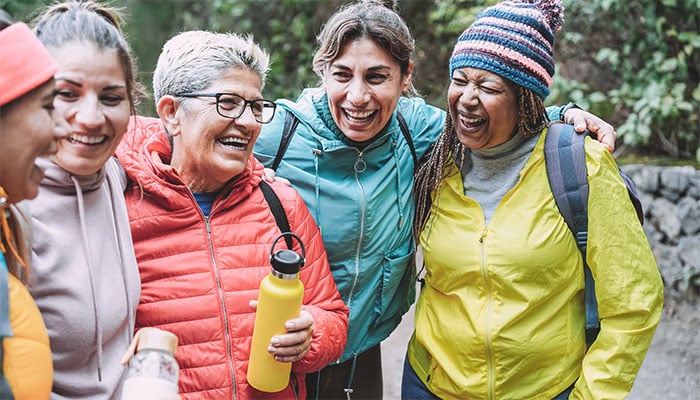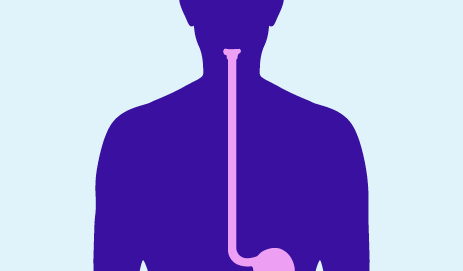World Cancer Research Fund has awarded a record level of funding for research into how diet, nutrition and physical activity can prevent, or help people survive, cancer.
The 19 successful research projects will investigate a range of cancers and risk factors, including the effect of coffee, cow milk and sweetened beverages on cancer, as well as the effect of physical activity on cancer survivors.
For the first time, World Cancer Research Fund has partnered with Cancer Australia in co-funding three research projects based in Australia, which investigate the role of diet, nutrition and physical activity in primary cancer prevention.
We are delighted to be funding so many exciting research projects this year. These research projects will help further our knowledge of the effects of diet, nutrition and physical activity on cancer prevention, and can make a real difference in preventing cancer and improving the lives of people living with cancer. – Dr Anna Diaz Font, Head of Research Funding at World Cancer Research Fund
The 19 new research grants are:
- Dr Laure Dossus, International Agency for Research on Cancer, France, £350,000: Obesity and endometrial cancer: integrative molecular tools to identify the underlying causal pathways
- Prof Dr Michael Leitzmann, University of Regensburg, Germany, £350,000: The combined impact of physical activity, sedentary behaviour, and cardiometabolic comorbidities on cancer risk and survival among cancer survivors (PaCoCanS)
- Dr James Thorne, University of Leeds, UK, £349,983: Developing a mechanistic understanding of how nutrient-metabolic gene pathways predict and modify responses to chemotherapy in breast cancer
- Prof Dr Ellen Kampman, Wageningen University, Netherlands, £349,915: Coffee, coffee metabolites, hepatic fat accumulation and colorectal cancer outcomes
- Assistant Prof Bethany Van Guelpen, Umea University, Sweden, £349,700: Exploring the role of inflammation in the link between obesity and colorectal cancer
- Dr Franzel van Duijnhoven, Wageningen University, Netherlands, £349,645: The role of vitamin D in the development of colorectal neoplasms in persons with Lynch syndrome
- Dr Dieuwertje Kok, Wageningen University, Netherlands, £349,055: Folate versus folic acid: connecting treatment tolerance to prognosis in colorectal cancer survivors
- Dr Alejandro Lucia and Carmen Fiuza Luces, Universidad Europea de Madrid, Spain, £345,119: Exercise and lifestyle intervention for patients with adolescent cancer: a randomised controlled trial
- Dr Tilman Kühn, Queen’s University of Belfast, UK, £330,321: Polyphenols and health outcomes among breast cancer survivors: a prospective biomarker study
- Dr Linda Denehy, University of Melbourne, Australia, £299,684: Rehabilitation after bone marrow transplant to improve patient outcomes. The REBOOT study
- Dr Robert MacInnis, Cancer Council Victoria, Australia, £299,073 (total grant co-funded with Cancer Australia*): Population-level relevance of preventable risk factors on the burden of cancer
- Dr Judith Kroep, Leiden University Medical Center, Netherlands, £289,834: DIRECT-2: a phase 3 trial on fasting mimicking diet to improve neoadjuvant ChemoTherapy in HR+, HER2- breast cancer
- Dr Neil Murphy, International Agency for Research on Cancer, France, £205,437: Identifying the risk factors underlying the rising rates of colorectal cancer in younger adults: a multi-cohort analyses of more than 3 million men and women
- Dr Sabine Rohrmann, University of Zurich, Switzerland, £98,700: Does planetary health mean population health? Adherence to a planetary health diet and cancer risk and survival in a prospective cohort study
- Dr Timo Bund, German Cancer Research Center, Germany, £60,000: Understanding the role of Bovine Meat and Milk Factors (BMMF) in chronic inflammation and colorectal cancer
- Prof Gail Garvey, University of Queensland, Australia £59,915 (total grant co-funded with Cancer Australia*): A feasibility study of an Indigenous Patient Navigator-led brief health behaviour intervention in Aboriginal and Torres Strait Islander cancer survivors
- Prof Matty Weijenberg, Maastricht University, Netherlands, £59,809: Identifying circadian eating and physical behaviour patterns associated with sleep quality, fatigue and inflammation after colorectal cancer treatment: a pilot study with unique data
- Dr Mitch Duncan, University of Newcastle, Australia, £58,450 (total grant co-funded with Cancer Australia*): MULTI-HEALTH: co-creating a technology based multiple behaviour intervention for cancer survivors at increased risk of CVD
- Dr Alessandro Carrer, Veneto Institute of Molecular Medicine, Italy, £54,800: Do sweetened beverage increase pancreatic cancer risk? Interrogating metabolic alterations induced by dietary fructose
*Cancer Australia was established by the Australian government in 2006 to benefit all Australians affected by cancer, and their families and carers. Cancer Australia aims to reduce the impact of cancer, address disparities and improve outcomes for people affected by cancer by leading and coordinating national, evidence-based interventions across the continuum of care.
We call for the adoption of legislation by the European Union (EU) to improve public health, prevent non-communicable diseases and promote children’s rights, by effectively protecting children from the harmful impact of the widespread, ubiquitous and insidious marketing of nutritionally poor food.
The EU has extensive powers to regulate all forms of cross-border marketing to improve the functioning of the internal market, whilst ensuring a high level of public health, consumer and children’s rights protection, in line with the EU Treaties and the EU Charter of Fundamental Rights.
We call on the EU to regulate the cross-border marketing of food and minimise the exposure of children to nutritionally poor food marketing by:
- Ending the marketing of nutritionally poor food between 6am and 11pm on broadcast media, including television and radio;
- Ending the marketing of nutritionally poor food on digital media, including social media and video sharing platforms;
- Ending the sponsorship by food brands of events with cross-border effects, including sports and cultural events, such as festivals, unless brands can prove that such sponsorship is not associated with nutritionally poor food; and
- Ending the use of marketing techniques appealing to children for the promotion of nutritionally poor food, including on food packages. In particular, influencers and other personalities shall not promote nutritionally poor food.
All children, including adolescents, must be protected from harmful marketing. A child is defined as any person below the age of 18, in line with the UN Convention on the Rights of the Child that all EU Member States have ratified.
The definition of nutritionally poor food should be based on the WHO Europe nutrient profile model.
We consider that action to create sustainable, empowering environments conducive to the good health and well-being of future generations is not only warranted, but also feasible. We therefore present a blueprint Food Marketing Directive as a discussion document to relaunch the debate on the protection by the EU of children from the harmful impact that the marketing of nutritionally poor food has on their health and on their rights.
“We are supporting the call for the European Union to protect children from the excessive marketing of unhealthy food and drinks. We know that marketing junk food to children encourages children to choose unhealthy products, which in turn can contribute to childhood obesity. Seeing just 4.4 minutes of junk food advertising leads to children eating an extra 60 calories a day.
“Childhood obesity and excess weight are significant health issues for children and their families. There can be serious implications for a child’s physical and mental health, which can continue into adulthood. We know that helping children get a healthy start in life is really important. By supporting children to eat healthily and get moving from an early age, we aim to help them develop healthy habits that could help reduce their risk of developing cancer and other diseases later in life.
“It’s time that we saw policies in place across the EU that protect children from this harmful marketing and put health first.” – Kate Oldridge-Turner, Head of Policy and Public Affairs at World Cancer Research Fund International
> Download a copy of the main statement and endorsing organisations
Oils and fats are a kitchen staple. But there’s a lot of conflicting information regarding how healthy each of them is. With so many to choose from, how do we know what we should be using?
Generally, if a fat is solid at room temperature, such as butter, coconut, lard and ghee, it is higher in saturated fats. These type of fats raise levels of “bad” LDL cholesterol, which isn’t good for our heart health. Therefore, we should limit how much saturated fat we consume.
If a fat is liquid at room temperature, such as olive and rapeseed oils, it has a higher proportion of unsaturated fats: monounsaturated and polyunsaturated – which are sometimes referred to as “good” fats. These fats (when they replace saturated-rich food such as butter in your diet) can have a favourable effect on our blood cholesterol levels, and help maintain a healthy heart.
Will eating oil and fat increase my risk of cancer?
World Cancer Research Fund has found no evidence that eating vegetable and seed oils in moderation increases the risk of cancer. In fact, a small amount of fat is essential and helps the body absorb vitamins A, D and E.
However, fats and oils are high in calories and are often found in processed foods such as cakes, pastries and biscuits. We know that frequently consuming high-calorie processed food can contribute to weight gain, overweight and obesity, which in turn can increase your risk of at least 13 different cancers.
“As part of a healthy diet, choose fats and oils lower in saturated fat and higher in unsaturated fats, in moderation. While a certain amount of fat is essential for our health, we should watch how much we use as it’s high in calories. Choosing the right type of oil or fat for your meal can help make sure that your dish is both delicious and nutritious!”
– Alison Bate, Registered Associate Nutritionist
How does cooking affect oils?
The term “smoke point” refers to the temperature at which oil begins to smoke. It occurs when components of the fats start to break down, which leads to the formation of compounds called free radicals that can be harmful to our health.
This can happen if you use an oil with a low smoke point for cooking at high temperatures. Before using any oil, make sure its smoke point can handle the cooking method you plan to use.
As a general rule of thumb, oils with a lower smoke point are best suited to cooking at low temperatures, while those with a higher smoke point are best suited to cooking at higher temperatures, such as frying.
Fats to avoid
Trans fat, a type of fat found in partially hydrogenated vegetable oil (a process where a liquid oil is turned into a solid fat), is particularly harmful to our health. It raises levels of “bad” LDL cholesterol and lowers the “good” HDL cholesterol. While many food manufacturers and retailers no longer use partially hydrogenated vegetable oils in the UK, it’s a good idea to check the label just in case.
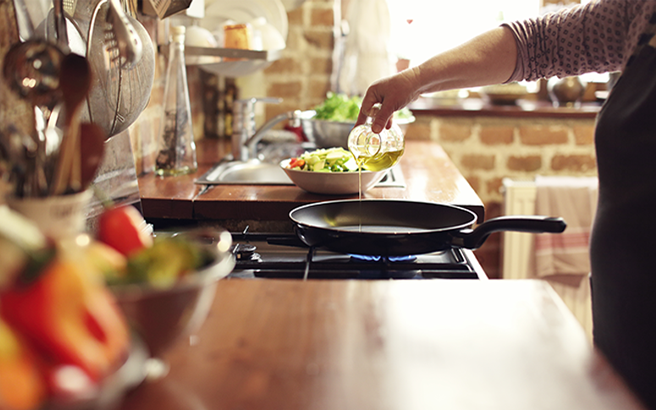
Your guide to cooking with oil
-
Extra virgin olive oil
Extracted from olives with minimal processing, this oil tends to be higher in antioxidants and vitamins, and is particularly rich in monounsaturated fats.
- Lower smoke point.
- Best for salad dressings, drizzling over pasta, and cooking at low temperatures.
-
Olive oil
A more processed version of extra virgin olive oil. The processing removes some of its beneficial compounds, such as antioxidants.
- Medium smoke point.
- Best for salad dressings and cooking at lower temperatures.
-
Rapeseed oil
Lower in saturated fat and higher in both monounsaturated and polyunsaturated fats – a healthier oil when used in moderation.
- High smoke point.
- Very versatile. Can be consumed in its cold natural form as a dressing or dip; or heated and used in shallow- and deep-frying, baking and roasting.
-
Avocado oil
Particularly rich in monounsaturated fat and also contains vitamin E.
- High smoke point.
- Best for frying, roasting and baking.
-
Coconut oil
Firm at room temperature because it is composed of around 85% saturated fat. Despite some health claims made about coconut oil and other coconut products, use it sparingly because of its high saturated fat content.
- Medium smoke point.
- Best for baking and sautéing.
-
Flaxseed oil
Lower in saturated fat and particularly rich in plant-based omega-3 (alpha-linolenic acid). As flaxseed oil has one of the lowest smoke points, it shouldn’t be cooked with.
- Best for salad dressings and drizzling.
-
Sesame oil
Rich in both monounsaturated and polyunsaturated fats, but also lower in saturated fat.
- High smoke point.
- Best for sautéing, stir-frying and frying.
-
Sunflower oil
Extracted from sunflower seeds, with a subtle flavour. Richest in polyunsaturated fats. Also contains monounsaturated fats.
- High smoke point.
- Best for roasting, stir-frying and deep-frying.
-
Butter, lard and ghee
Higher in saturated fat (around 60%), and should be used sparingly.
- Medium smoke point.
- Best for baking and worst for cooking at high temperatures.
-
Margarine and spreads
Most margarine is made from a blend of vegetable oils, which makes it lower in saturated fat than butter and higher in unsaturated fat.
- Medium smoke point.
- Best for baking.

Sign up to our policy newsletter
Get the latest news and updates direct to your inbox

Sign up for emails
Get our monthly digest of the latest research, health tips and advice, recipes and much more
